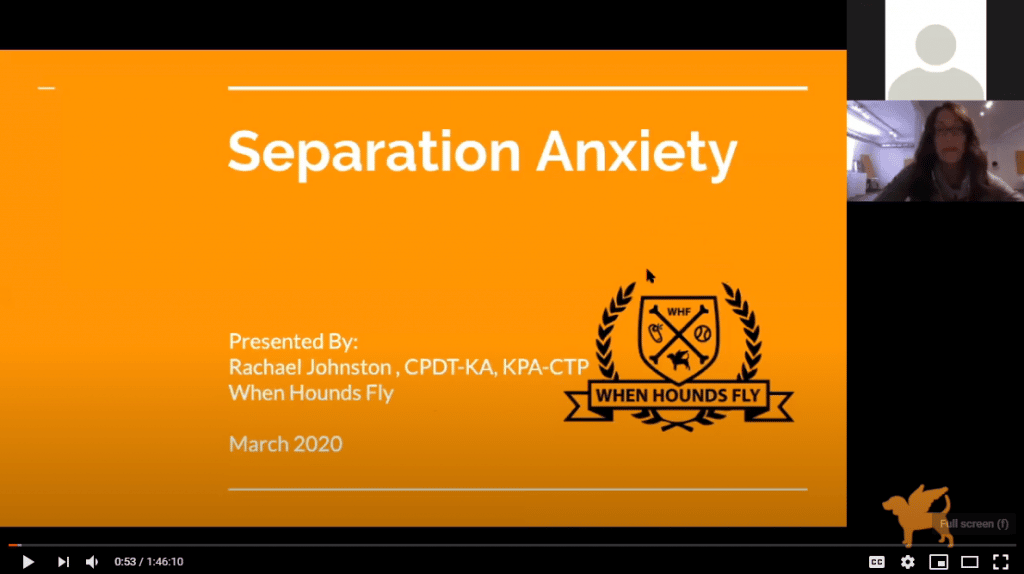What is Separation Anxiety?
Separation anxiety is a condition in dogs where emotionally and physiologically, the dog becomes panic stricken when he’s apart from his owner or people in general. Typically it manifests itself when a dog is left home alone.
- Behaviors that occur when a dog is suffering from separation anxiety:
- Urination (a normally housebroken dog will soil within minutes of being left alone)
- Vomiting
- Self-mutilation (licking his/her own paws excessively till the fur is gone and the skin is raw)
- Destroying objects (pillows, shoes, door trim, trying to eat the door)
- Barking or howling
Some physiological signs include:
- Sweaty paws
- Glazed eyes
- Panting
- Excessive pacing
Why does it develop?
There are many reasons why a dog may develop separation anxiety. It has been observed that puppies that are transported by air cargo during puppyhood (specifically, around 8-11 weeks) have a higher likelihood of developing separation anxiety. It also develops when a dog never has the opportunity to practice being alone, especially when growing up as a puppy (for example, an owner who takes time off from work and is with the puppy 24/7 for weeks at a time). Major lifestyle changes such as a work-from-home person suddenly having to go to an office 9-5, or moving to a new home can also cause separation anxiety to appear later in life.
Regardless of the reason, it is a major reason why dogs end up in shelter (Dogs can bark and howl loudly – if they have separation anxiety, the owners get eviction notices).
Don’t confuse Separation Anxiety for Boredom
A dog that chews your shoes when you’re gone may just be bored and wanted to chew your shoe. Similarly, a dog that soils in the house when left alone may just not be housebroken – or you left them at home for longer than their bladder could handle. Look for sweaty paw prints, drool puddles, glazed eyes, etc. as signs that it is separation anxiety and not a general training issue. Recording your dog with a camera when you’re gone is a good way to tell.
Treating Separation Anxiety
- Confirm that your dog actually has separation anxiety. An expert’s eye can help you figure out whether your dog is really suffering from this, or is perhaps just slightly anxious in a new home environment, or is bired
- Suspend Absences – If confirmed, then to treat the problem, the straightest line is the suspension of absences. This will require planning, forethought, resources (both time and money), and ideally a support system of people
- Implement Confinement Training and Planned Departures
What is a Planned Departure?
A planned departure is leaving your home for a set amount of time strictly for the purposes of desensitizing your dog to being left alone. If you pack up and leave, you may find your dog is silent for 1 minute at first, then the barking or urination starts at 1:01. If that’s his threshold, you leave for 55 seconds, and then return. Repeat at 56 seconds, then 57, and slowly move your way up. Doing as many as you can sporadically through the day is the best way to do this.
Over days and weeks you’ll move from increments of seconds to minutes – over time your dog will be able to tolerate being alone and loose for longer and longer periods. Once you get up to about the 10 minute mark, it’s easy to integrate this practice to your daily life – 10 minutes is enough time to go to the corner store to pick up milk, or walk to the video store to return a movie, go to the bank ATM, etc. The more reasons to leave and come back the better.
After weeks and months of work, you’ll break the 60 minute mark – at that point you’ll be able to leave your dog alone to go to the gym, eat at a neighbourhood restaurant, etc. By that time your dog should be OK to be alone for 3+ hours at a time.
Just make sure the dog is well exercised, has been opportunities to relieve himself, and you’ve left lots of chew toys and stuffed kongs (and hidden your prized pair of shoes or other at risk objects) to set your dog up for success.
Use webcams and audio recording software to help you collect useful data about whether your dog’s anxiety is getting better over time.
It is important as you work up on your departure durations to avoid leaving the dog home alone for longer than they can handle. This may mean heavy reliance on dog daycares, friends, family, and a severe impact on your social life in the short-term.
Here’s a video of a beagle that suffers from Separation Anxiety. Notice that the dog ignores food that is left behind – he is too stressed to eat – a sign that he suffers from moderate to severe separation anxiety (mildly anxious dogs will still eat when left alone).
Learn More:
We have a 90 minute recording of a livestreamed webinar where we go over in detail the Separation Anxiety treatment protocol and answer many commonly asked questions. If you’d like to get access to this, click here and fill in the form and we’ll send you a link to view the webinar.
Get Help From Us!
We offer consultations to anyone, anywhere via videoconference. Separation Anxiety is a behaviour problem that does not require us at all for hands-on training, instead, we will coach you and help you design and implement your training plan. We’ll also watch live and recorded footage of your sessions to help you as you progress. Click here to learn more about our Separation Anxiety consultation services.
Further resources to help:
Treating Separation Anxiety in Dogs by Malena Demartini-Price

